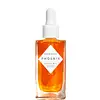What's inside
What's inside
 Key Ingredients
Key Ingredients

 Benefits
Benefits

 Concerns
Concerns

 Ingredients Side-by-side
Ingredients Side-by-side

Simmondsia Chinensis Seed Oil
EmollientRosa Canina Seed Oil
EmollientLimnanthes Alba Seed Oil
Skin ConditioningSalvia Hispanica Seed Oil
MoisturisingCaprylic/Capric Triglyceride
MaskingSimmondsia Chinensis Seed Oil, Rosa Canina Seed Oil, Limnanthes Alba Seed Oil, Salvia Hispanica Seed Oil, Caprylic/Capric Triglyceride, Hippophae Rhamnoides Oil, Tocopherol, Ubiquinone, Rosa Damascena Flower Extract, Citrus Aurantium Flower Oil, Linalool, Citronellol, Geraniol, Limonene, Eugenol, Farnesol
Rosa Canina Seed Extract
EmollientSimmondsia Chinensis Seed Oil
EmollientBorago Officinalis Seed Oil
EmollientCorylus Avellana Seed Oil
EmollientOenothera Biennis Seed Extract
Skin ConditioningTriticum Vulgare Germ Oil
EmollientParfum
MaskingTocopherol
AntioxidantHelianthus Annuus Seed Oil
EmollientBakuchiol
AntimicrobialGlycine Soja Oil
EmollientBeta-Carotene
Skin ConditioningCanola Oil
EmollientRosmarinus Officinalis Leaf Extract
AntimicrobialAscorbyl Palmitate
AntioxidantCitronellol
PerfumingCoumarin
PerfumingHexyl Cinnamal
PerfumingHydroxycitronellal
PerfumingLimonene
PerfumingLinalool
PerfumingRosa Canina Seed Extract, Simmondsia Chinensis Seed Oil, Borago Officinalis Seed Oil, Corylus Avellana Seed Oil, Oenothera Biennis Seed Extract, Triticum Vulgare Germ Oil, Parfum, Tocopherol, Helianthus Annuus Seed Oil, Bakuchiol, Glycine Soja Oil, Beta-Carotene, Canola Oil, Rosmarinus Officinalis Leaf Extract, Ascorbyl Palmitate, Citronellol, Coumarin, Hexyl Cinnamal, Hydroxycitronellal, Limonene, Linalool
 Reviews
Reviews

Ingredients Explained
These ingredients are found in both products.
Ingredients higher up in an ingredient list are typically present in a larger amount.
Citronellol is used to add fragrance/parfum to a product. It is often derived from plants such as roses. In fact, it can be found in many essential oils including geranium, lavender, neroli, and more. The scent of Citronellol is often described as "fresh, grassy, and citrus-like".
Since the Citronellol molecule is already unstable, Citronellol becomes irritating on the skin when exposed to air.
Citronellol is a modified terpene. Terpenes are unsaturated hydrocarbons found in plants. They make up the primary part of essential oils.
Citronellol is not able to be absorbed into deeper layers of the skin. It has low permeability,
Citronellol is also a natural insect repellent.
Learn more about CitronellolLimonene is a fragrance that adds scent and taste to a formulation.
It's found in the peel oil of citrus fruits and other plants such as lavender and eucalyptus. The scent of limonene is generally described as "sweet citrus".
Limonene acts as an antioxidant, meaning it helps neutralize free radicals.
When exposed to air, oxidized limonene may sensitize the skin. Because of this, limonene is often avoided by people with sensitive skin.
The term 'fragrance' is not regulated in many countries. In many cases, it is up to the brand to define this term. For instance, many brands choose to label themselves as "fragrance-free" because they are not using synthetic fragrances. However, their products may still contain ingredients such as essential oils that are considered a fragrance.
Learn more about LimoneneLinalool is a fragrance and helps add scent to products. It's derived from common plants such as cinnamon, mint, citrus, and lavender.
Like Limonene, this ingredient oxidizes when exposed to air. Oxidized linalool can cause allergies and skin sensitivity.
This ingredient has a scent that is floral, spicy tropical, and citrus-like.
Learn more about LinaloolThis oil comes from the seeds of the desert shrub called Jojoba. It is more commonly known as jojoba oil, a non-comedogenic oil.
Jojoba oil does not contain fragrance and has many fatty-acids, making it a great soothing ingredient.
It also contains Vitamin E, a great moisturizing ingredient. Vitamin E is also an antioxidant and protects your skin against oxidative damage.
This ingredient humectant properties, meaning it helps draw moisture from the air. This helps keep your skin hydrated.
While jojoba has antibacterial properties, it is only able to kill some strains of bacteria.
Studies also show it helps in wound healing. In fact, Indigenous cultures have used jojoba as a moisturizer and to help treat burns for centuries.
Fun fact: Jojoba oil similar to natural human skin sebum, so it has a great effect on dry skin. It is also promising with helping to regulate sebum production.
Due to its fatty acid content, Jojoba oil may not be fungal acne safe. We recommend speaking with a professional if you have any concerns.
Learn more about Simmondsia Chinensis Seed OilTocopherol (also known as Vitamin E) is a common antioxidant used to help protect the skin from free-radicals and strengthen the skin barrier. It's also fat soluble - this means our skin is great at absorbing it.
Vitamin E also helps keep your natural skin lipids healthy. Your lipid skin barrier naturally consists of lipids, ceramides, and fatty acids. Vitamin E offers extra protection for your skin’s lipid barrier, keeping your skin healthy and nourished.
Another benefit is a bit of UV protection. Vitamin E helps reduce the damage caused by UVB rays. (It should not replace your sunscreen). Combining it with Vitamin C can decrease sunburned cells and hyperpigmentation after UV exposure.
You might have noticed Vitamin E + C often paired together. This is because it is great at stabilizing Vitamin C. Using the two together helps increase the effectiveness of both ingredients.
There are often claims that Vitamin E can reduce/prevent scarring, but these claims haven't been confirmed by scientific research.
Learn more about Tocopherol